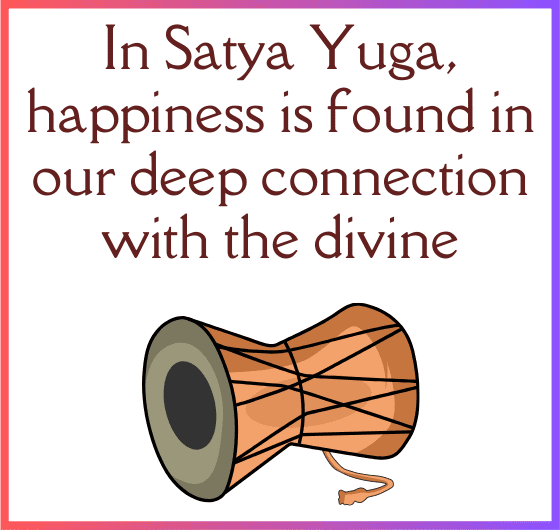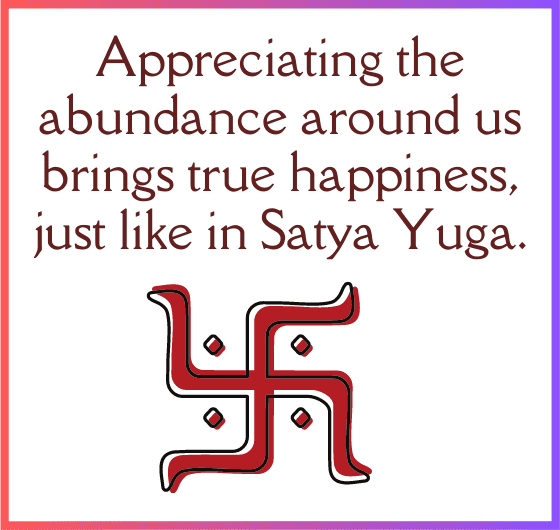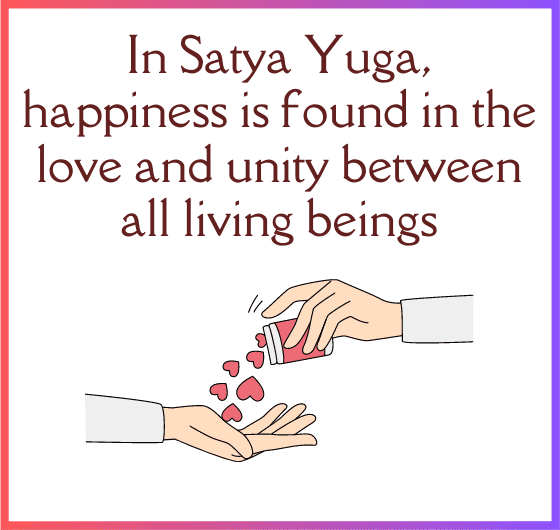Satya Yuga, also known as the “Age of Truth” or the “Golden Age” and is believed to be the first of the four yugas (ages) in Hindu cosmology. It represents an era of spiritual enlightenment, righteousness, and harmony. In this article, we will explore the essence of Satya Yuga and uncover the extract of happiness that prevailed during this idyllic period.
The Golden Age of Satya Yuga: Unveiling the Era of Perfection and Bliss
From the virtuous society and perfect harmony to the direct experience of the divine and the absence of material desires, Satya Yuga offers valuable insights into the factors that contribute to true happiness and fulfillment. Let us embark on a journey into this mythical age and discover the timeless wisdom it holds, as follows:-
Section 1: The Virtuous Society: Satya Yuga was characterized by a society of extraordinary virtue and great righteousness. In Satya Yuga, people were believed to possess:
>> High moral character,
>> Honesty, and
>> Integrity in their thoughts, words, and actions.
The essence of happiness in Satya Yuga stemmed from the deep-rooted values that governed individuals’ lives.
>> The purity of intentions,
>> Selflessness, and
>> Adherence to dharma (righteousness) formed the foundation of this virtuous society.
The people respected and honored one another, creating an atmosphere of trust and harmony.
“Through a strong connection with the divine, we find solace in the storms, guidance in the chaos, and purpose in the unknown.”

Section 2: Perfect Harmony: Satya Yuga was characterized by perfect harmony between humans, nature, and the divine. There was no strife, conflict, or suffering. People lived in peace and coexistence with all living beings.
“In the symphony of life, perfect harmony is found when the notes of love, understanding, and unity intertwine, creating a melody that resonates with the essence of our souls.”
In this age, people lived in profound coexistence with the natural world, recognizing the inherent interconnectedness of all beings. The extract of happiness lay in the unity and oneness experienced by individuals, as they understood that they were an integral part of a larger cosmic tapestry.
In Satya Yuga, people lived in harmony with each other and nature. They treated the environment and all living beings with great respect. This peaceful way of living made everyone happy and created a strong feeling of connection between all things.
This harmonious existence fostered a deep sense of peace, contentment, and interconnectedness, contributing to the overall happiness of the inhabitants of Satya Yuga.
Section 3: Direct Experience of the Divine: One of the remarkable aspects of Satya Yuga was the direct and intimate connection between individuals and the divine. Spiritual practices were deeply ingrained in daily life, and people sought a direct experience of the divine through meditation, contemplation, and self-realization.
The extract of happiness was found in the deep communion with the cosmic consciousness and the profound sense of oneness experienced by individuals. In Satya Yuga,
In those times, the line of separation between humans and the divine was very thin. This made people more aware of the spiritual world and feel deeply connected to the source of happiness that goes beyond our everyday lives.
Spiritual practices, such as meditation and yoga, were deeply rooted in everyday life, enabling individuals to experience oneness with the cosmic consciousness.
“Yoga is the journey of the self, through the self, to the self. It is a practice that nurtures the body, calms the mind, and awakens the spirit, revealing the boundless potential within.”
Section 4: Absence of Material Desires: Satya Yuga was characterized by the absence of materialistic desires and ego-driven motivations. Individuals were content with simple living and focused their energies on spiritual growth and self-realization.
In this age, happiness was not tied to external possessions or achievements, but rather to inner fulfillment and spiritual progress. The extract of happiness lay in the detachment from material attachments, allowing individuals to find contentment and joy within themselves.
“Materialistic desires and ego-driven motivations were minimal in Satya Yuga.”

Section 5: The Evolution of Souls: Satya Yuga is considered a time of spiritual evolution and enlightenment. Souls were believed to be at their purest and closest to the divine during this age. Individuals had the opportunity to progress spiritually, attaining higher states of consciousness and wisdom. The extract of happiness in Satya Yuga was intimately linked to the spiritual growth and evolution of souls, as they journeyed closer to their ultimate realization.
Section 6: Human Longevity and Vitality: In Satya Yuga, human beings were said to possess extraordinary longevity, with lifespans lasting for thousands of years. The human body was believed to be pure and healthy, with minimal disease or physical ailments.
Section 7: Limited Population: The population during Satya Yuga was relatively small, and communities lived in close-knit harmony. Resources were abundant, and there was no need for competition or exploitation.
Section 8: Evolution of Souls: Satya Yuga is considered a time of spiritual evolution and enlightenment. Souls were believed to be at their purest and closest to the divine. It was an opportunity for individuals to progress spiritually and attain higher states of consciousness.
“The divine: a guiding light, a source of peace, and a reminder of our connection to something greater.”
It’s important to note that the descriptions of Satya Yuga come from ancient Hindu scriptures, such as the Puranas and the Mahabharata. These accounts are seen as allegorical and symbolic rather than literal historical records. Satya Yuga is often depicted as an idealized era representing the highest spiritual aspirations of humanity”
Conclusion: Satya Yuga, the Golden Age, offers a vision of a harmonious and spiritually enlightened era. People lived in a virtuous society, characterized by righteousness,
>> Integrity, and
>> High moral values.
Perfect harmony prevailed, not only among humans but also with nature and the divine. The direct experience of the divine was a central aspect of life in Satya Yuga, fostering a profound sense of oneness and spiritual connection.
Moreover, the absence of material desires allowed individuals to find happiness within themselves, detached from external possessions. Satya Yuga was a time of spiritual evolution, where souls had the opportunity to progress towards higher states of consciousness and wisdom.
Although Satya Yuga is considered a mythical age, it offers valuable insights into the elements that contribute to true happiness and fulfillment.
Why Satya Yuga was filled with Happiness?
** Satya Yuga, also known as the Golden Age, was a time of spiritual enlightenment and happiness.
** People in Satya Yuga had high moral character, honesty, and integrity.
** Society was virtuous, with a deep sense of righteousness and adherence to dharma (righteousness).
** There was perfect harmony between humans, nature, and the divine.
** People lived in unity and recognized the interconnectedness of all beings.
** Harmony extended to the environment, with respect and reverence for nature.
** The direct experience of the divine was central to life in Satya Yuga.
** Spiritual practices like meditation and self-realization were deeply ingrained.
** Individuals felt a profound connection with the cosmic consciousness, leading to a sense of oneness.
** Materialistic desires were minimal, and people found happiness within themselves.
** Inner fulfillment and spiritual growth were prioritized over material possessions.
** Souls evolved and progressed spiritually during Satya Yuga.
** It was a time of heightened spiritual awareness and wisdom.
** Satya Yuga offers valuable insights into true happiness and fulfillment.
** We can draw inspiration from Satya Yuga’s virtues and incorporate them into our lives.
** By embodying righteousness, harmony, and spirituality, we can cultivate happiness.
** Detachment from material desires and inner growth contribute to contentment.
** Although Satya Yuga is a mythical age, its teachings can guide us toward happiness.
** Moreover, we may not recreate Satya Yuga, but we can find inspiration in its essence.
Embracing the wisdom of Satya Yuga can lead to a happier and more fulfilling life.

The Extract of Happiness from Satya Yuga lies in the virtues of:-
>> Righteousness,
>> Harmony,
>> Spirituality,
>> Detachment, and
>> Inner growth.
While we may not be able to recreate the exact conditions of Satya Yuga in our present age, we can draw inspiration from its essence and incorporate its teachings into our lives.
By embodying values of integrity, harmony, and spiritual connection, we can cultivate a deeper sense of happiness and fulfillment.
By prioritizing inner growth and detaching ourselves from material desires, we can find contentment within ourselves.
The extract of happiness from Satya Yuga serves as a guiding light, reminding us of the timeless wisdom that can inspire and uplift us on our own personal journeys toward happiness and fulfillment.
“Satya Yuga is era characterized by virtue, harmony, and spirituality”
Conclusion
Satya Yuga was an era of spiritual enlightenment, harmony, and happiness. People lived virtuous lives, recognized the interconnectedness of all beings, and had a direct experience of the divine. They found happiness within themselves and prioritized spiritual growth.
While we may not replicate Satya Yuga, we can learn from its teachings to lead happier lives today. By embracing righteousness, harmony, and spirituality, we can find contentment and inner peace. Let the wisdom of Satya Yuga guide us on our journey toward happiness and fulfillment.
“The extract of happiness from Satya Yuga lies in the virtuous society, perfect harmony, direct experience of the divine, absence of material desires, and the evolution of souls”
Long ago, people wrote stories in ancient Hindu books like the Puranas and the Mahabharata. These stories tell us about something called Satya Yuga. But here’s the thing: these stories aren’t meant to be taken as exact facts like in a history book. Instead, they use symbols and special meanings to teach us important lessons.
Satya Yuga is like a magical time that represents the best of what humans can be. It’s like an ideal world where people have the highest spiritual goals and dreams. So, when we talk about Satya Yuga, we’re talking about something special and meaningful from those old stories.
Four interesting facts about Satya Yuga:-
1.. Perfect Harmony: Satya Yuga was a time of perfect harmony, where people lived in peace and unity. They treated each other with kindness and respect, creating a world free from conflicts and disputes.
2. Divine Connection: During Satya Yuga, the connection between humans and the divine was strong. People had a deep spiritual awareness and felt closely connected to a higher power. This connection brought them immense happiness and fulfillment.
3. Ethical Living: In Satya Yuga, moral values were upheld with utmost sincerity. Honesty, compassion, and righteousness were deeply ingrained in people’s lives. They strived to live according to these virtues, creating a society of integrity and virtue.
4. Abundance and Longevity: Satya Yuga was characterized by abundance and prosperity. The Earth was fertile, providing an abundance of resources, and people enjoyed long and healthy lives. It was a time of great well-being and fulfillment.

Which God was born in Satya Yuga?
In Satya Yuga, the ancient time, according to Hindu mythology, the god believed to have been born is Lord Vishnu. Lord Vishnu is an important deity in Hinduism known as the preserver and protector of the universe.
During Satya Yuga, Lord Vishnu appeared in different forms called avatars, to bring balance and righteousness to the world. One of his avatars in Satya Yuga was Matsya, the fish incarnation. Lord Vishnu took the shape of a giant fish to save a man named Manu, along with plants and animals, from a huge flood.
Apart from Matsya, Lord Vishnu’s other avatars like Kurma, the tortoise, Varaha, the boar, and Narasimha, the half-man and half-lion, are also said to have appeared in Satya Yuga. They came to protect the good people and defeat the forces of evil.
The birth of Lord Vishnu’s avatars in Satya Yuga represents divine intervention to restore harmony and righteousness in a world where goodness prevailed. These avatars are highly respected for their brave acts and teachings, which inspire people to lead virtuous lives and do what is right.
It’s important to remember that the stories and beliefs about Lord Vishnu’s avatars in Satya Yuga are considered religious and mythical. They hold deep spiritual and moral significance for followers of Hinduism.
Was there Evil in Satyug?
In Satya Yuga, the first and most virtuous age according to Hindu mythology, evil was believed to be very minimal or practically non-existent. Satya Yuga was characterized by a prevailing sense of righteousness, harmony, and goodness.
During this age, people were said to possess high moral values and lived in perfect alignment with dharma, which represents righteous actions and duties. The society in Satya Yuga was described as peaceful, where truth and justice prevailed. The inhabitants of Satya Yuga were deeply devoted to spiritual practices and had a strong connection with the divine.
However, while evil forces may have existed in a minor capacity, they were greatly overshadowed by the prevalence of righteousness. The influence of negative traits such as greed, hatred, and deceit was minimal during this age. Satya Yuga is often portrayed as an idealized era, emphasizing the purest form of existence.
Also, it is important to note that the absence of evil in Satya Yuga serves as a symbolic representation of the ultimate goodness and harmony that humanity aspires to achieve. The concept of evil gains more prominence in subsequent ages, as described in Hindu mythology, where the prevalence of adharma (unrighteousness) gradually increases.
Overall, Satya Yuga is revered as a time of spiritual enlightenment, purity, and a harmonious existence where the forces of evil are believed to be minimal compared to the ages that follow.
Four life lessons we can take away from Satya Yuga:-
1.. Unity and Kindness: Satya Yuga teaches us the importance of unity and kindness. Just as people in Satya Yuga lived in harmony and treated each other with respect, we can learn to embrace unity and kindness in our interactions with others. It reminds us that a compassionate and inclusive attitude can create a more harmonious and supportive world.
2. Spirituality and Connection: Satya Yuga highlights the significance of spirituality and connection with the divine. It encourages us to nurture our spiritual growth, seek inner peace, and cultivate a deeper connection with something greater than ourselves. By exploring our spirituality, we can find meaning, guidance, and a sense of fulfillment in our lives.
3. Ethical Living: Satya Yuga emphasizes the importance of ethical living. It reminds us to uphold honesty, integrity, and moral values in our actions and decisions. By practicing ethical behavior, we contribute to the well-being of ourselves, others, and the world around us.
4. Appreciation of Abundance: Satya Yuga teaches us to appreciate the abundance in our lives. It reminds us to be grateful for the resources, opportunities, and blessings we have. By cultivating a mindset of gratitude, we can find contentment, joy, and a deeper sense of fulfillment in our daily lives.
Moreover, these life lessons from Satya Yuga serve as valuable reminders for us to embrace unity, kindness, spirituality, ethical living, and gratitude in our own lives, ultimately leading to personal growth, happiness, and a more harmonious world.

How long is 1 yug?
In Hindu cosmology, a Yug refers to a specific time cycle or age. The duration of one Yug is believed to be immensely long, spanning thousands of years. Each Yug is characterized by different qualities and spiritual conditions, marking the evolution of human civilization and consciousness.
The duration of one Yug varies according to different sources and interpretations within Hindu scriptures. According to traditional calculations, one Yug consists of four ages or sub-Yugas: Satya Yuga, Treta Yuga, Dvapara Yuga, and Kali Yuga. The total duration of all four Yugas is said to be 4,320,000 years.
Satya Yuga, the first and most virtuous age, lasts for 1,728,000 years. Treta Yuga follows, lasting for 1,296,000 years. Dvapara Yuga continues for 864,000 years, and finally, Kali Yuga, the current age of darkness and spiritual decline, lasts for 432,000 years.
It’s important to note that these time durations are symbolic and not to be taken literally. They represent the gradual deterioration of moral and spiritual values as human civilization progresses through the Yugas.
Understanding the duration of one Yug helps us appreciate the vastness of time and the cyclical nature of existence according to Hindu cosmology. It provides a broader perspective on the spiritual evolution and the transient nature of human affairs in the grand cosmic scheme.

